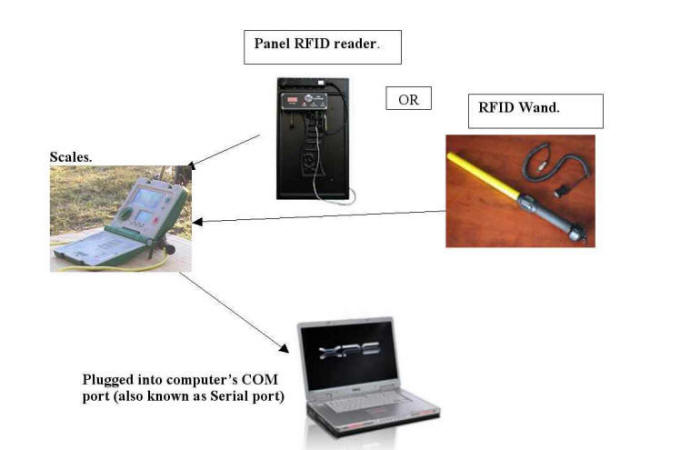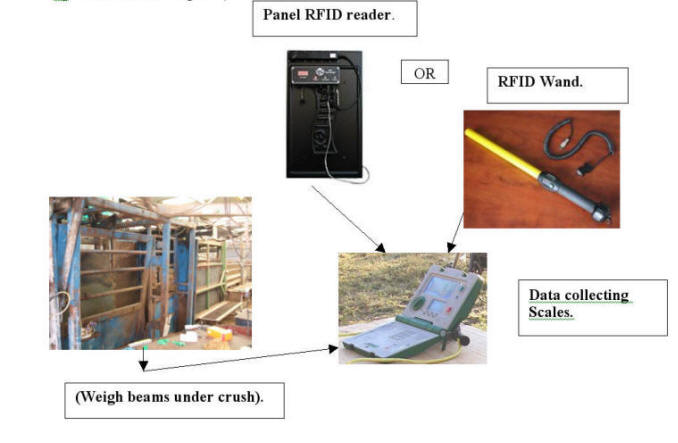How do we collect data?
This section of the manual gives you a general overview of the flow of data.
The Cattle Fattening Records system is designed for individual animal recording. At first glance you may think this is unnecessary, but the management benefits derived are crucial. If cattle from different sources are processed in mobs there is no way to identify which individual sources have supplied the better performing cattle. And the data collection process using today’s technology is much simpler than you may initially think.
Electronic ID tracking has made life much simpler for the cattle industry, because an animal can be quickly identified.
This system collects individual animal data, but has the capabilities of applying common data to a large mob of cattle very easily. Specific details about individual animals (Sickness, drug costs etc) can be added at will.
There are various methods used for collecting the main bulk of cattle processing data for entry into a computer :
- Use a computer in the cattle yards for direct entry into the database as cattle are processed.
- Collect the information into electronic scales capable of storing data. The scales are then taken to the office, and the data stored within is uploaded to a computer system.
-
Write down the information collected (Tag Number,
weight, breed etc) for later manual entry into a computer system. (Not to be
recommended – takes too much time).
Example 1: Using a computer in the cattle yards.

Example 2: Using scales that can collect and store Ear Tag numbers, RFID tag numbers and the weight. (eg TruTest, Ruddweigh etc).

Step 1.
Cattle are processed and basic data such as Tag number, weight, breed etc is stored in the scales. One of these data items stored should be used to identify the “Group” of cattle that each beast belongs to.
Step 2.
The scales containing all the data collected are taken to the office. Here they are connected to the computer running the Cattle Fattening Records system.
Step 3.
The cattle database is updated automatically with data from the scales. You can optionally add more data that is applicable to all cattle at this point, but you may want to delay this and do it later in Step 4.
Step 4.
More data about groups of animals will come to hand as time progresses, such as their cost (per head or per unit weight). The Batch Update process is used to update the database with this common data. For example, you can select all the cattle belonging to a particular Group, and record their cost, the drugs given during processing, the Pen Number they went to, their Purchase Lot number, and so forth.
You can also record data for individual animals in special cases – for example when they suffer some sickness and are given antibiotics.
Step 5.
As cattle are fed in the feedlot environment, you basically record that X weight of feed worth Y dollars was deposited into a pen on a certain date. The system will automatically record that each animal was fed that day (feed weight divided by number of head in Pen) along with the cost. You can also continue to use the Batch Update process if more common data is to be applied to a selection of animals.
Step 6 (optional).
If cattle are on a “long feed” regimen, you may want to weigh them again at convenient intervals to ascertain weight gains. Use the same process as in steps 1 to 3 above to record Intermediate weights.
Step 7.
When cattle leave the feedlot, their RFID numbers can be collected as they are loaded onto a truck. This list of RFIDs can be used to update the database, recording that they have been “sold”.
Step 8.
Carcase data can be collected electronically from a data file emailed by the Abattoir, or from the NLIS system (in Australia). This data will be used to update your database, by using the RFID numbers to match records.
We now have data for all animals that have been through the fattening process. The management reporting system within the software package can now be used to ascertain performance of individual Groups all animals by a variety of parameters.